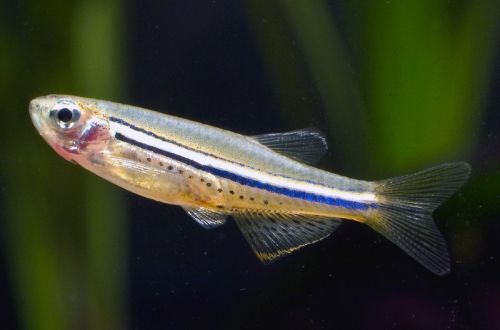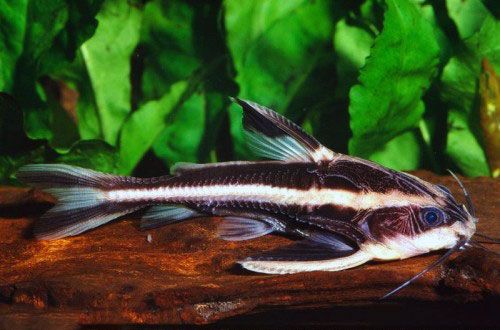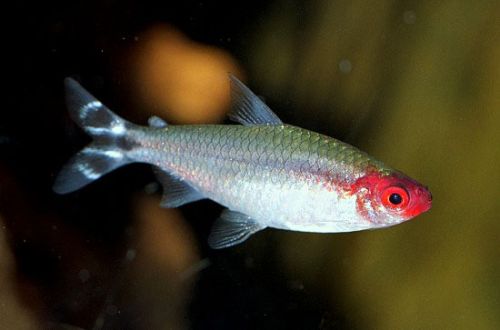
Spotted Danio
Spotted Danio, scientific name Danio nigrofasciatus, belongs to the Cyprinidae family. Not a typical representative of Danio, its main feature is that in some cases the male and female form a permanent pair and remain faithful to each other for several mating seasons, which is extremely rare among cyprinids. Otherwise, this is an ordinary aquarium fish, which can be called pretty, thanks to the original body pattern.

Contents
Habitat
It comes from Southeast Asia from the territory of modern Myanmar (Burma) in its central part. The habitat is subject to seasonal changes: the period from November to April is characterized as relatively cool and dry by tropical standards – water bodies are partially drained, and the period from May to September is marked by high temperatures and heavy rainfall – flooding of vast flat areas occurs. Danio prefers small rivers and streams, small ponds with rich coastal vegetation, and is also found in ditches and rice fields during the rainy season.
Brief information:
- The volume of the aquarium – from 60 liters.
- Temperature – 18-26°C
- Value pH — 6.0–7.5
- Water hardness – soft (2-12dGH)
- Substrate type – rocky dark
- Lighting – moderate
- Brackish water – no
- Water movement is weak
- The size of the fish is up to 4 cm.
- Meals – any
- Temperament – peaceful, active
- Keeping in a flock of 8-10 individuals
Description
Adults reach a length of only 4 cm, while females are somewhat larger, but inferior to males in grace and color. The predominant body color is silvery with a characteristic pattern in the form of a horizontal blue-white (rarely blue-yellow) stripe stretching from head to tail. In the lower part of the body under the stripe there are several blue specks.
Food
Undemanding to food, they accept all types of dry, frozen and live food. The diet directly affects the color of the fish, so it is advisable to combine different types of products, for example, combine flakes and granules with bloodworms, daphnia.
Maintenance and care, arrangement of the aquarium
The recommended volume of the tank for one flock of fish is from 60 liters. Design elements include a rocky substrate of small pebbles, pebbles and a few smooth boulders, a number of shelters in the form of snags, tree roots and branches, as well as plants located along the side and back walls of the aquarium.
The set of equipment is standard and consists of a heater, aerator, filtration and lighting systems. When choosing a filter, consult with a specialist and select a model that will provide good water purification and will not create excessive internal flow. Spotted Danio is poorly adapted to turbulent streams and in its natural habitat adheres to areas with calm water. The presence of a cover is mandatory, the fish are prone to jumping out.
The water parameters are characterized by a slightly acidic pH value and a low concentration of dissolved calcium and magnesium salts (dGH index). The temperature regime has a wide permissible range, therefore, in the warm season, additional heating of the aquarium is not required.
Aquarium maintenance comes down to a weekly replacement of part of the water with fresh and periodic cleaning of the soil from organic waste, and glass from plaque.
Behavior and Compatibility
Very peaceful, agile fish, but by nature quite timid. Only species similar in size and temperament can be used as neighbors. The content is flocking, at least 8-10 individuals, being in the community they will not be so shy. In addition, Danio males will show their best coloration in an effort to attract the attention of females.
Breeding / breeding
Spotted Danio belongs to spawning species, females scatter eggs near thickets of plants, and males at this moment fertilize it. This species is less prolific than other Danios; in one mating season, a pair of fish can produce no more than 50 eggs. Parental instincts are poorly developed, immediately after spawning, the fish can eat their own caviar and fry that have appeared. However, it was noted that some fish form stable pairs, sometimes remaining for several seasons.
Breeding is recommended to be carried out in a separate tank – a spawning aquarium, in order to protect offspring from adult fish. The design is simple, the main attention is paid to the ground, it should consist of particles of a sufficiently large size that do not fit tightly to each other, forming voids, for example, pebbles or decorative glass beads. When the eggs sink to the bottom, most of them fall into these voids and thus become inaccessible to fish. A similar effect is also achieved when using a fine mesh, which is fixed at the bottom.
Another way to ensure the preservation of eggs is to use low-growing small-leaved plants or mosses such as Riccia floating and Javanese moss, which are planted on most of the surface of the substrate (in this case, the soil can be any). Dense thickets of plants can provide reliable shelter for eggs no worse than special soil.
The size of the spawning aquarium is usually 15-20 liters, half filled. The equipment used is an aerator, a heater and a simple sponge filter of low power to prevent accidental suction of eggs and fry. Spawning occurs in dim light, so at first there is no need for a light source.
The impetus for the beginning of the mating season is the establishment of a water temperature in the region of the upper permissible mark of 24–25 ° C at a slightly acidic pH value, as well as the inclusion of protein foods in the daily diet – bloodworms, daphnia, brine shrimp in live or frozen form.
After some time, the females become noticeably rounder, and the males will acquire a brighter color and begin to actively show signs of attention to their chosen ones. At this point, you should prepare a separate tank and fill it with water from the general aquarium, then transplant several females and the most colorful males there.
To initiate spawning, it is necessary to add a small portion of cool water every few hours and thereby gradually lower the temperature to about 20 ° C. If you carry out this procedure in the evening, then in the morning everything will be finished. The easiest way to determine the end of spawning is by females, they will become slender.
The fish are returned. The fry will appear in 24 – 36 hours, and in another day they will begin to swim freely. Feed with specialized microscopic food for feeding juvenile aquarium fish.
Fish diseases
A balanced diet and suitable living conditions are the best guarantee against the occurrence of diseases in freshwater fish, so if the first symptoms of an illness appear (discoloration, behavior), the first thing to do is check the condition and quality of the water, if necessary, return all values to normal, and only then do treatment. Read more about symptoms and treatments in the Aquarium Fish Diseases section.





